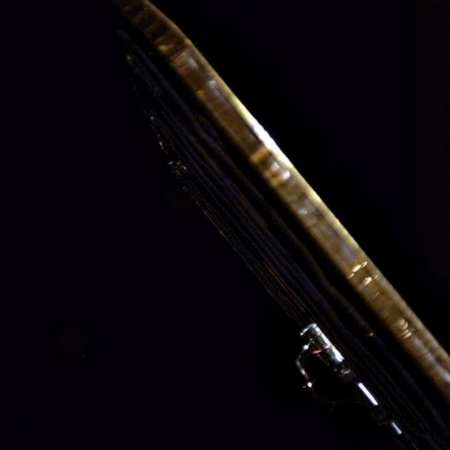Twin Escapade Mars orbiters take first images to test instruments
The two twin Escapade Mars orbiters, built by Rocket Lab, that were launched last week by Blue Origin’s New Glenn rocket have both successfully activated and tested their optical and infrared cameras.
The optical picture to the right, reduced to post here, shows the side of one solar panel on one of the orbiters.
The images prove the cameras are working well. The visible-light image also suggests that the spacecraft should have the sensitivity to image Martian aurora from orbit. The infrared camera will be used at Mars to better understand how materials on the surface heat up and cool down during Mars’ day-night cycle and over the planet’s seasons.
The second ESCAPADE spacecraft also successfully took its first photos, but it was targeted toward deep space, so the images were simply black.
The NASA press release did not explain why the second spacecraft’s camera was pointed in that manner. One would think the engineers would want it to look at the spacecraft in order to test its pointing and resolution. It could be it is placed in this manner and cannot be changed, or it could be there is a problem not mentioned by the release.
The two spacecraft are taking a different path to Mars than normal. Both will remain as Lagrange Point 2, a million miles from Earth until November 2026, when they will then be sent back towards Earth to slingshot past to arrive at Mars in September 2027. This plan allowed the spacecraft to be launched with greater flexibility, rather than be tied to the launch windows that occur every two years that all other Mars probes have used.
On Christmas Eve 1968 three Americans became the first humans to visit another world. What they did to celebrate was unexpected and profound, and will be remembered throughout all human history. Genesis: the Story of Apollo 8, Robert Zimmerman's classic history of humanity's first journey to another world, tells that story, and it is now available as both an ebook and an audiobook, both with a foreword by Valerie Anders and a new introduction by Robert Zimmerman.
The print edition can be purchased at Amazon or from any other book seller. If you want an autographed copy the price is $60 for the hardback and $45 for the paperback, plus $8 shipping for each. Go here for purchasing details. The ebook is available everywhere for $5.99 (before discount) at amazon, or direct from my ebook publisher, ebookit. If you buy it from ebookit you don't support the big tech companies and the author gets a bigger cut much sooner.
The audiobook is also available at all these vendors, and is also free with a 30-day trial membership to Audible.
"Not simply about one mission, [Genesis] is also the history of America's quest for the moon... Zimmerman has done a masterful job of tying disparate events together into a solid account of one of America's greatest human triumphs."--San Antonio Express-News
The two twin Escapade Mars orbiters, built by Rocket Lab, that were launched last week by Blue Origin’s New Glenn rocket have both successfully activated and tested their optical and infrared cameras.
The optical picture to the right, reduced to post here, shows the side of one solar panel on one of the orbiters.
The images prove the cameras are working well. The visible-light image also suggests that the spacecraft should have the sensitivity to image Martian aurora from orbit. The infrared camera will be used at Mars to better understand how materials on the surface heat up and cool down during Mars’ day-night cycle and over the planet’s seasons.
The second ESCAPADE spacecraft also successfully took its first photos, but it was targeted toward deep space, so the images were simply black.
The NASA press release did not explain why the second spacecraft’s camera was pointed in that manner. One would think the engineers would want it to look at the spacecraft in order to test its pointing and resolution. It could be it is placed in this manner and cannot be changed, or it could be there is a problem not mentioned by the release.
The two spacecraft are taking a different path to Mars than normal. Both will remain as Lagrange Point 2, a million miles from Earth until November 2026, when they will then be sent back towards Earth to slingshot past to arrive at Mars in September 2027. This plan allowed the spacecraft to be launched with greater flexibility, rather than be tied to the launch windows that occur every two years that all other Mars probes have used.
On Christmas Eve 1968 three Americans became the first humans to visit another world. What they did to celebrate was unexpected and profound, and will be remembered throughout all human history. Genesis: the Story of Apollo 8, Robert Zimmerman's classic history of humanity's first journey to another world, tells that story, and it is now available as both an ebook and an audiobook, both with a foreword by Valerie Anders and a new introduction by Robert Zimmerman.
The print edition can be purchased at Amazon or from any other book seller. If you want an autographed copy the price is $60 for the hardback and $45 for the paperback, plus $8 shipping for each. Go here for purchasing details. The ebook is available everywhere for $5.99 (before discount) at amazon, or direct from my ebook publisher, ebookit. If you buy it from ebookit you don't support the big tech companies and the author gets a bigger cut much sooner.
The audiobook is also available at all these vendors, and is also free with a 30-day trial membership to Audible.
"Not simply about one mission, [Genesis] is also the history of America's quest for the moon... Zimmerman has done a masterful job of tying disparate events together into a solid account of one of America's greatest human triumphs."--San Antonio Express-News


